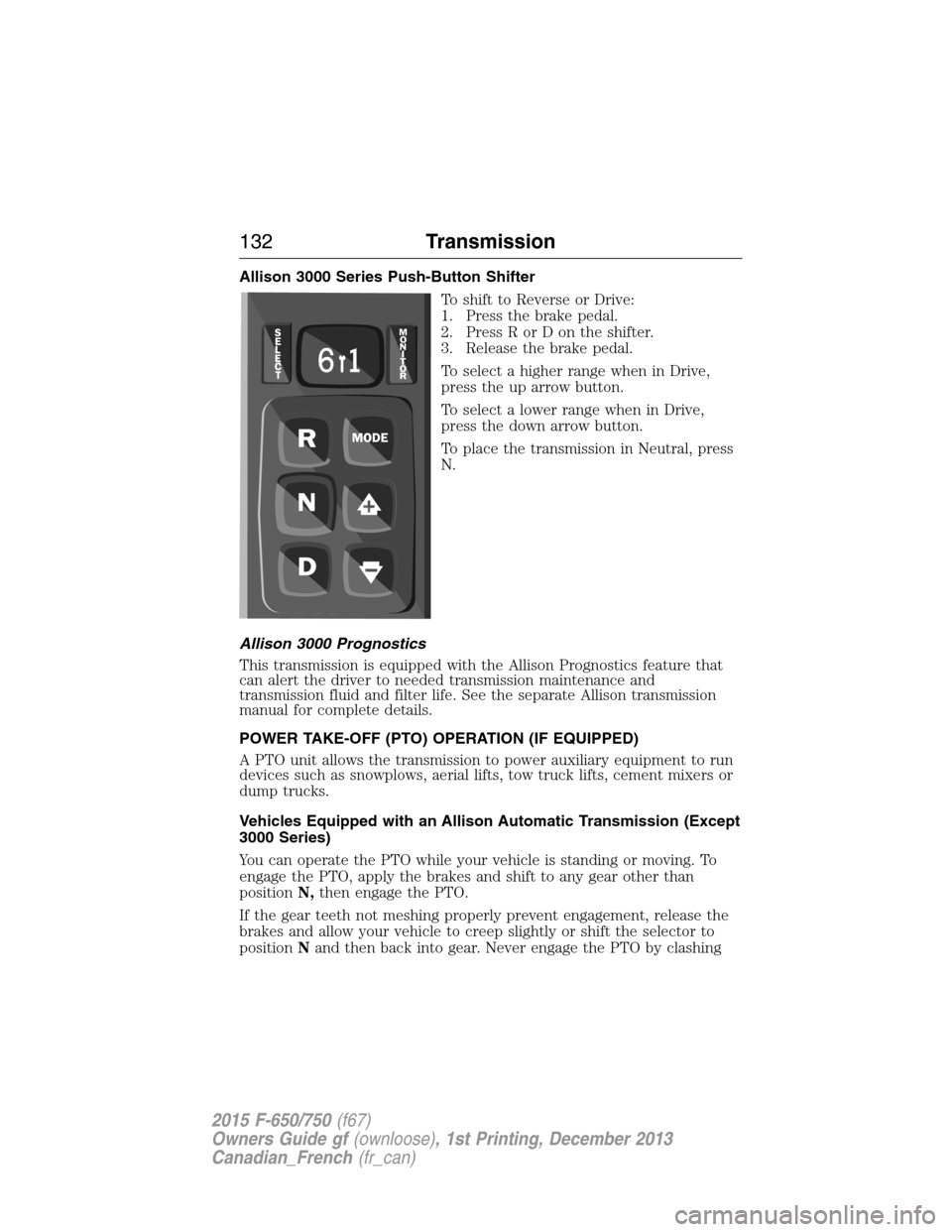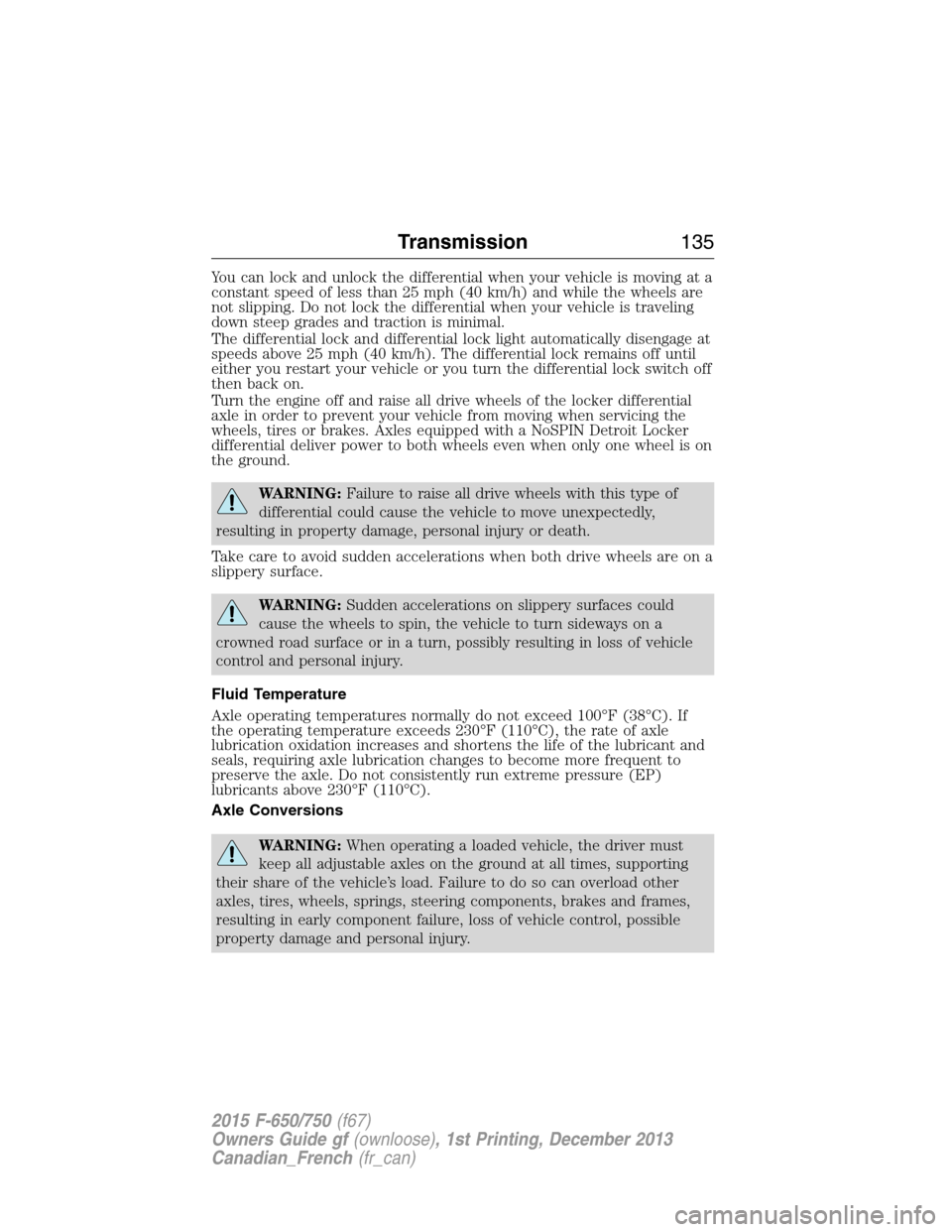2015 FORD F650 transmission fluid
[x] Cancel search: transmission fluidPage 5 of 384

Fuses 187
Changing a fuse......................................187
Fuse specification chart................................188
Fuses and relays......................................196
Maintenance 197
General information...................................197
Opening and closing the hood............................208
Engine oil dipstick....................................210
Engine oil check......................................210
Engine coolant check..................................211
Automatic transmission fluid check........................215
Brake fluid check.....................................220
Power steering fluid check..............................222
Fuel filter...........................................224
Washer fluid check....................................224
Changing the vehicle battery.............................224
Checking the wiper blades..............................227
Changing the wiper blades..............................228
Air filter(s).........................................228
Adjusting the headlamps................................231
Changing a bulb......................................231
Bulb specification chart.................................233
4Table of Contents
2015 F-650/750(f67)
Owners Guide gf(ownloose), 1st Printing, December 2013
Canadian_French(fr_can)
Page 17 of 384

Engine starting (with parking brake applied)
Steering linkage
free playInspect for excessive free play in the steering
linkages. The steering wheel should have less
than 2 inches (5 centimeters) of free play at its
rim.
Full power
hydraulic brake
inspectionPump the brake pedal several times with the
ignition in the off or run position. You can
momentarily hear the motor and pumps
replenishing the accumulators.
Parking brakeVerify the parking brake holds the vehicle by
gently trying to pull forward with the parking
brake applied.
Air brakesVerify operation using the following procedure.
Chock the wheels, if necessary. Push in the
parking brake and, on tractors, push in the
tractor parking brake knob:
1. Verify the air compressor or governor cutout
pressure is approximately 120 psi (827 kPa).
2. Turn off the engine, and then turn the key
back to the on position (without starting the
engine).
3. Without the brake pedal applied, note the air
pressure drop for one minute. It should be less
than 2 psi (14 kPa) for single vehicles and 3 psi
(21 kPa) for combination vehicles.
4. Press and hold the brake pedal with 90 psi
(621 kPa) or more. Make sure there is no more
than a 3–psi (21 kPa) per minute leak for single
vehicles and a 4–psi (28 kPa) per minute leak for
combination vehicles.
5. Pump the brake pedal to deplete the system of
air pressure. The warning light and tone should
turn on at 57 psi (393 kPa).
6. Pump the brake pedal and make sure the
parking brake and trailer parking brake knobs
pop out at 20 psi (138 kPa) or higher.
Automatic
transmission fluidVerify that the fluid level is in the proper
operating range. SeeTransmission fluid check
in theMaintenancechapter.
16Vehicle Inspection Guide
2015 F-650/750(f67)
Owners Guide gf(ownloose), 1st Printing, December 2013
Canadian_French(fr_can)
Page 23 of 384

Trailer
If you are pulling a trailer, perform an inspection of the trailer similar to
that of the tractor. The inspection should follow trailer manufacturer
recommendations and should include at a minimum: general condition,
landing gear, doors, sides, lights, reflectors, suspension, brakes, tires,
wheels, cargo placement, stability and tie-downs.
Transmission
WARNING:If the unit starts in gear and/or the neutral start
switch is not functioning correctly, the vehicle may inadvertently
move which could result in property damage, personal injury or death.
If your vehicle is equipped with an automatic transmission, regularly
inspect the transmission’s neutral start switch. The engine should only
start in positionNorP.
Inspect the transmission fluid level and shift linkage for proper
operation.
22Vehicle Inspection Guide
2015 F-650/750(f67)
Owners Guide gf(ownloose), 1st Printing, December 2013
Canadian_French(fr_can)
Page 66 of 384

GAUGES - GASOLINE ENGINE
Cluster shown in standard measure. Metric similar.
A. Engine oil pressure gauge
B. Engine coolant temperature gauge
C. Transmission fluid temperature gauge
D. Fuel gauge
E. Speedometer
F. Information display. See theInformation Displayschapter for more
information.
G. Tachometer
Engine Oil Pressure Gauge
Indicates engine oil pressure. The needle should stay in the normal
operating range. If the needle falls below the normal range, stop the
vehicle, turn off the engine and check the engine oil level. Add oil if
needed. If the oil level is correct, have your vehicle checked at an
authorized dealer.
ABCD
GFE
Instrument Cluster65
2015 F-650/750(f67)
Owners Guide gf(ownloose), 1st Printing, December 2013
Canadian_French(fr_can)
Page 67 of 384

Engine Coolant Temperature Gauge
Indicates engine coolant temperature. At normal operating temperature,
the level indicator is in the normal range. If the engine coolant
temperature exceeds the normal range, stop the vehicle as soon as safely
possible, switch off the engine and let the engine cool.
WARNING:Never remove the coolant reservoir cap while the
engine is running or hot.
Transmission Fluid Temperature Gauge
Indicates transmission fluid temperature. At normal operating
temperature, the level indicator is in the normal range. If the
transmission fluid temperature exceeds the normal range, stop the
vehicle as soon as safely possible and verify the airflow is not restricted,
such as snow or debris blocking airflow through the grill. Special
operating conditions, such as snowplowing, towing or off-road use, can
also cause higher than normal operating temperatures. Internal
transmission damage may occur if you operate the transmission for
extended periods with the gauge in the higher than normal area.
Changing the severity of the driving conditions may help lower the
transmission temperature into the normal range. If the gauge continues
to show high temperatures, see an authorized dealer.
Fuel Gauge
Indicates approximately how much fuel is in the fuel tank (when the
ignition is on). The fuel gauge may vary slightly when your vehicle is
moving or on a grade. The fuel icon and arrow indicates which side of
the vehicle the fuel filler door is located.
Information Display
Odometer:Located in the bottom of the information display. Registers
the accumulated distance your vehicle has travelled.
Trip Computer:SeeGeneral informationin theInformation Displays
chapter.
Vehicle Settings and Personalization:SeeGeneral informationin
theInformation Displayschapter.
66Instrument Cluster
2015 F-650/750(f67)
Owners Guide gf(ownloose), 1st Printing, December 2013
Canadian_French(fr_can)
Page 70 of 384

Diesel Exhaust Fluid (diesel engine only)
It illuminates when the diesel exhaust fluid level falls below
0.5 gallons (1.9L) in the 5- gallon (19.0L) tank or one gallon
(3.8L) in the 9-gallon (34.0L) tank. Refill the tank or, at a
minimum, add at least one gallon (3.8L) to the 5- gallon (19.0L) tank or
two gallons (7.6L) to the 9- gallon (34.0L) tank.
Diesel Particulate Filter (diesel engine only)
It illuminates when the soot level in the diesel particulate filter
has reached a point where it requires operator assistance. See
Diesel particulate filterin theMaintenancechapter, and your
engine operator’s manual, for more details.
Do Not Shift (Allison automatic transmission only)
It illuminates while driving if a transmission problem exists;
shifting may be restricted. Depending on the severity of the
problem, the shifter’s digital read-out may turn blank.
Operation may continue in order to reach service assistance. The control
unit may not respond to shift selector requests, since there are operating
limitations on the transmission (such as. upshift and downshift
restrictions). Direction changes do not occur.
Direction Indicator
It illuminates when you turn on the left or right turn signal or
the hazard warning flasher. If the indicators stay on or flash
faster, check for a burned out bulb.
Electronic Locking Differential
It illuminates when using the electronic locking differential.
Engine Oil Pressure (gasoline engine only)
It illuminates when engine oil pressure is low.
Fasten Safety belt
It illuminates and a tone sounds to remind you to fasten your
safety belt.
Instrument Cluster69
2015 F-650/750(f67)
Owners Guide gf(ownloose), 1st Printing, December 2013
Canadian_French(fr_can)
Page 133 of 384

Allison 3000 Series Push-Button Shifter
To shift to Reverse or Drive:
1. Press the brake pedal.
2. Press R or D on the shifter.
3. Release the brake pedal.
To select a higher range when in Drive,
press the up arrow button.
To select a lower range when in Drive,
press the down arrow button.
To place the transmission in Neutral, press
N.
Allison 3000 Prognostics
This transmission is equipped with the Allison Prognostics feature that
can alert the driver to needed transmission maintenance and
transmission fluid and filter life. See the separate Allison transmission
manual for complete details.
POWER TAKE-OFF (PTO) OPERATION (IF EQUIPPED)
A PTO unit allows the transmission to power auxiliary equipment to run
devices such as snowplows, aerial lifts, tow truck lifts, cement mixers or
dump trucks.
Vehicles Equipped with an Allison Automatic Transmission (Except
3000 Series)
You can operate the PTO while your vehicle is standing or moving. To
engage the PTO, apply the brakes and shift to any gear other than
positionN,then engage the PTO.
If the gear teeth not meshing properly prevent engagement, release the
brakes and allow your vehicle to creep slightly or shift the selector to
positionNand then back into gear. Never engage the PTO by clashing
132Transmission
2015 F-650/750(f67)
Owners Guide gf(ownloose), 1st Printing, December 2013
Canadian_French(fr_can)
Page 136 of 384

You can lock and unlock the differential when your vehicle is moving at a
constant speed of less than 25 mph (40 km/h) and while the wheels are
not slipping. Do not lock the differential when your vehicle is traveling
down steep grades and traction is minimal.
The differential lock and differential lock light automatically disengage at
speeds above 25 mph (40 km/h). The differential lock remains off until
either you restart your vehicle or you turn the differential lock switch off
then back on.
Turn the engine off and raise all drive wheels of the locker differential
axle in order to prevent your vehicle from moving when servicing the
wheels, tires or brakes. Axles equipped with a NoSPIN Detroit Locker
differential deliver power to both wheels even when only one wheel is on
the ground.
WARNING:Failure to raise all drive wheels with this type of
differential could cause the vehicle to move unexpectedly,
resulting in property damage, personal injury or death.
Take care to avoid sudden accelerations when both drive wheels are on a
slippery surface.
WARNING:Sudden accelerations on slippery surfaces could
cause the wheels to spin, the vehicle to turn sideways on a
crowned road surface or in a turn, possibly resulting in loss of vehicle
control and personal injury.
Fluid Temperature
Axle operating temperatures normally do not exceed 100°F (38°C). If
the operating temperature exceeds 230°F (110°C), the rate of axle
lubrication oxidation increases and shortens the life of the lubricant and
seals, requiring axle lubrication changes to become more frequent to
preserve the axle. Do not consistently run extreme pressure (EP)
lubricants above 230°F (110°C).
Axle Conversions
WARNING:When operating a loaded vehicle, the driver must
keep all adjustable axles on the ground at all times, supporting
their share of the vehicle’s load. Failure to do so can overload other
axles, tires, wheels, springs, steering components, brakes and frames,
resulting in early component failure, loss of vehicle control, possible
property damage and personal injury.
Transmission135
2015 F-650/750(f67)
Owners Guide gf(ownloose), 1st Printing, December 2013
Canadian_French(fr_can)